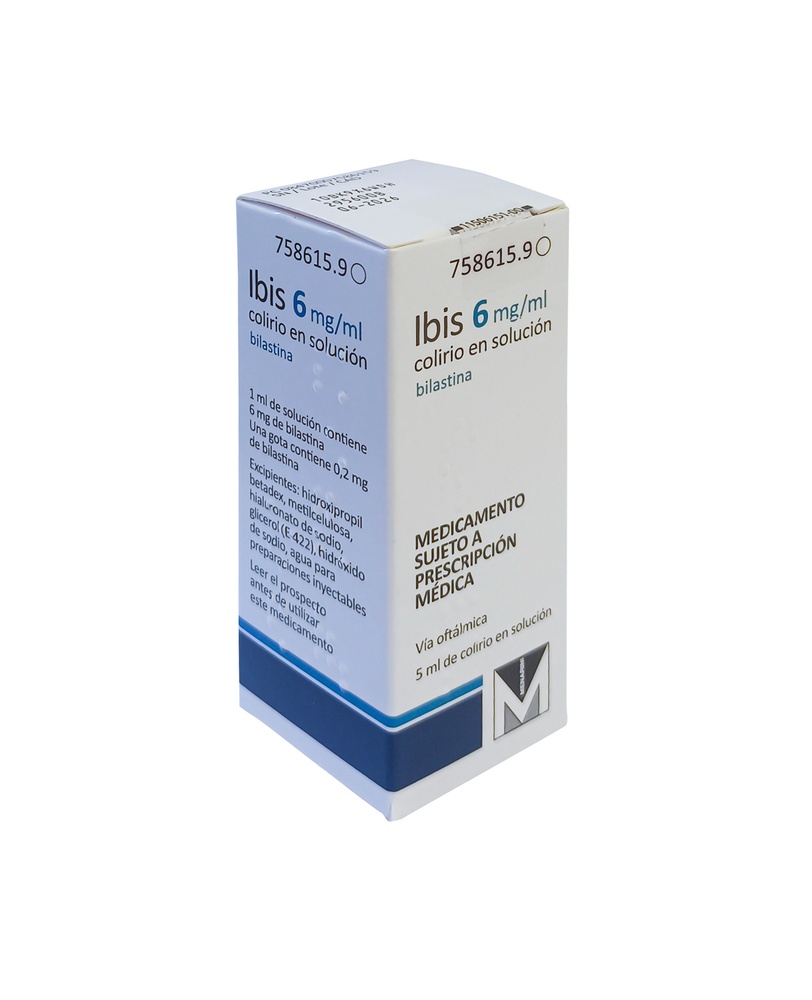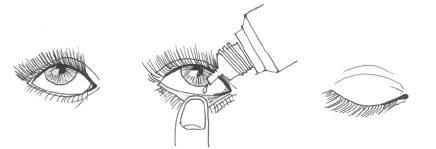

IBIS 6 mg/ml EYE DROPS SOLUTION

Ask a doctor about a prescription for IBIS 6 mg/ml EYE DROPS SOLUTION

How to use IBIS 6 mg/ml EYE DROPS SOLUTION
Introduction
Patient Information Leaflet
Ibis 6 mg/ml eye drops solution
bilastine
Read the entire leaflet carefully before starting to use this medication, as it contains important information for you.
- Keep this leaflet, as you may need to read it again.
- If you have any questions, consult your doctor or pharmacist.
- This medication has been prescribed to you only, and you should not give it to others, even if they have the same symptoms as you, as it may harm them.
- If you experience side effects, consult your doctor or pharmacist, even if they are not listed in this leaflet. See section 4.
Contents of the leaflet
- What Ibis is and what it is used for
- What you need to know before using Ibis
- How to use Ibis
- Possible side effects
- Storage of Ibis
- Package contents and additional information
1. What Ibis is and what it is used for
This medication contains bilastine, which belongs to a group of medications called antihistamines. Antihistamines work by preventing the effects of a substance called histamine, which the body produces as part of an allergic reaction.
This medication is used to treat the signs and symptoms of eye disorders that occur with seasonal allergic conjunctivitisin adults and children from 2 years of age.
This medication is also used to treat the signs and symptoms of eye disorders caused by an allergy to substances such as house dust mites or animal hair (perennial allergic conjunctivitis)in adults and children from 2 years of age.
2. What you need to know before using Ibis
Do not use Ibis
- if you are allergic to bilastine or any of the other components of this medication (listed in section 6).
Warnings and precautions
Consult your doctor or pharmacist before starting to use Ibis if, during treatment, side effects occur, such as eye irritation, pain, redness, or vision changes, or if your disease worsens. It may be necessary to interrupt treatment.
After administering the antiallergic eye drops of Ibis in the conjunctival sac of the eye, visual acuity may decrease for a few minutes due to the formation of spots.
In the case of inflammation, including allergic conjunctivitis, consult your ophthalmologist if you can use contact lenses despite symptoms.
Children and adolescents
This medication is indicated in adults and children from 2 years of age.
Do not administer this medication to children under 2 years of age, as its efficacy and safety have not been studied in these groups.
Other medications and Ibis
Tell your doctor or pharmacist if you are using, have recently used, or may need to use any other medication.
If you are using other eye medications, leave at least 5 minutes between each medication.
Ophthalmic ointments should be administered last.
Pregnancy, breastfeeding, and fertility
Ibis can be used during pregnancy and breastfeeding. If you are pregnant or breastfeeding, think you may be pregnant, or plan to become pregnant, consult your doctor or pharmacist before using this medication.
Driving and using machines
After instillation of this medication, temporary blurred vision or other visual disturbances may occur that affect the ability to drive or use machines. Wait until your vision is clear before driving or using machinery.
Contact lenses
The use of this medication does not affect the properties of contact lenses. You can continue to use contact lenses during the use of this medication.
You should remove your contact lenses before applying the eye drops and not put them back until 15 minutes after administration.
3. How to use Ibis
Follow the instructions for administration of this medication exactly as indicated by your doctor or pharmacist. If in doubt, consult your doctor or pharmacist again.
The recommended dose for adults and children from 2 years of age is one drop in each affected eye once a day.
This medication can be used for up to 8 weeks. Your doctor will decide and advise you on how long you should use it based on your situation.
For ocular use only.
Method of administration
- Always wash your hands and dry them with a clean towel before administering this medication.
- Gently clean your eyelids if there is discharge by rubbing the eyelid with the eye closed from the inner to the outer corner with a cotton swab moistened with warm water.
- Open the bottle and avoid contact between the dropper tip and your eye or any other surface: the drops and droppers must be kept clean.
- Tilt your head back, or lie down, and look up (Figure 1). Using your finger, pull the lower eyelid down (Figure 2).
- Look up and squeeze to release one drop into the eye.
- Release the lower eyelid and keep the eye closed for a moment to spread the drop over the eye surface (Figure 3).
- Repeat the above action in the other eye if necessary.


To avoid contamination during the use of this medication, do not touch any surface (eyelids, areas around the eye, or other surfaces) with the dropper tip, and wipe the dropper tip with a clean paper towel after use to remove any residual liquid.
If you use more Ibis than you should
You can rinse with warm water. In case of doubt, consult your doctor. Also, in case of overdose or accidental ingestion, you can consult the Toxicological Information Service Tel.: 91 562 04 20.
If you forget to use Ibis
Do not use a double dose to make up for forgotten doses.
If you forget to apply the drop on time, apply the forgotten drop as soon as possible and then return to your regular dosing schedule.
If you interrupt treatment with Ibis
Treatment with this medication should be carried out regularly, if possible, until the symptoms are relieved. If you stop using Ibis while still being exposed to allergens, you can expect the typical symptoms of the allergy to return.
If you have any other questions about the use of this medication, consult your doctor or pharmacist.
4. Possible side effects
Like all medications, this medication can cause side effects, although not everyone will experience them.
The following side effects have been reported.
Uncommon side effects (may affect up to 1 in 100 people):
Taste disturbance (dysgeusia), headache.
Dry eye, eye discharge, eye irritation, increased tear production, eye discomfort.
If one of the above side effects occurs, stop using this medication and consult your doctor directly. The mentioned side effects are usually mild and disappear quickly in all cases. Therefore, no specific measures are required.
Reporting side effects
If you experience any side effects, consult your doctor or pharmacist, even if they are not listed in this leaflet. You can also report them directly through the Spanish Medicines and Healthcare Products Agency (AEMPS) website (http://www.aemps.gob.es/). By reporting side effects, you can help provide more information on the safety of this medication.
5. Storage of Ibis
Keep this medication out of sight and reach of children.
Do not use this medication after the expiration date stated on the label or packaging after CAD. The expiration date is the last day of the month indicated.
This medication does not require special storage conditions.
After the first opening of the bottle:do not use this medication if the bottle has been open for more than 2 months.
Medications should not be disposed of through wastewater or household waste. Deposit the packaging and medications you no longer need at the pharmacy's SIGRE point. If in doubt, ask your pharmacist how to dispose of the packaging and medications you no longer need. This will help protect the environment.
6. Package contents and additional information
Composition of Ibis
- The active ingredient is bilastine 6 mg/ml.
One drop contains 0.2 mg of bilastine.
- The other components are hydroxypropyl betadex, methylcellulose, sodium hyaluronate, glycerol (E 422), sodium hydroxide 1N (for pH adjustment), and water for injectable preparations.
Appearance of the product and package contents
Ibis are transparent and colorless eye drops, contained in 1 multidose LDPE white bottle with 5 ml of preservative-free solution, with an HDPE white dropper and a tamper-evident security system.
Package size: 1 bottle of 5 ml.
Marketing authorization holder and manufacturer
Marketing authorization holder
Menarini International Operations Luxembourg, S.A.
1, Avenue de la Gare
L-1611 Luxembourg
Local representative:
Laboratorios Menarini, S.A.
Alfons XII, 587 – 08918 Badalona (Barcelona), Spain
Manufacturer
FAMAR Health Care Services Madrid, S.A.U.
Avenida Leganés, 62
28923 Alcorcón, Madrid
Spain
This medication is authorized in the Member States of the European Economic Area under the following names:
Germany: Bilaxten 6 mg/ml eye drops, solution;
Austria: Olisir 6 mg/ml eye drops, solution;
Belgium: Bellozal 6 mg/ml eye drops, solution;
Croatia: Nixar 6 mg/ml eye drops, solution;
Cyprus: Bilaz 6mg/ml οφθαλμικ?ς σταγ?νες;
Slovenia: Bilador 6 mg/ml eye drops, solution;
Spain: Ibis 6 mg/ml eye drops solution;
Estonia: Opexa;
France: Bilaska 6 mg/ml eye drops, solution;
Greece: Bilaz;
Hungary: Lendin 6 mg/ml eye drops;
Ireland: Drynol 6 mg/ml eye drops, solution;
Italy: Olisir 6 mg/ml eye drops, solution;
Latvia: Opexa 6 mg/ml eye drops, solution;
Lithuania: Opexa 6 mg/ml eye drops, solution;
Luxembourg: Bellozal 6 mg/ml eye drops, solution;
Malta: Gosall 6 mg/ml eye drops, solution;
Poland: Clatra;
Portugal: Lergonix 6 mg/ml eye drops, solution;
Czech Republic: Xados;
Slovakia: Omarit 6 mg/ml eye drops;
Romania: Borenar 6 mg/ml eye drops, solution.
Date of the last revision of this leaflet:June 2025
Detailed information about this medication is available on the website of the Spanish Agency for Medicines and Healthcare Products (AEMPS) (http://www.aemps.gob.es/).

How much does IBIS 6 mg/ml EYE DROPS SOLUTION cost in Spain ( 2025)?
The average price of IBIS 6 mg/ml EYE DROPS SOLUTION in December, 2025 is around 18.8 EUR. Prices may vary depending on the region, pharmacy, and whether a prescription is required. Always check with a local pharmacy or online source for the most accurate information.
- Country of registration
- Average pharmacy price18.8 EUR
- Availability in pharmaciesSupply issue reported
- Active substance
- Prescription requiredYes
- Manufacturer
- This information is for reference only and does not constitute medical advice. Always consult a licensed doctor before taking any medication. Oladoctor is not responsible for medical decisions based on this content.
- Alternatives to IBIS 6 mg/ml EYE DROPS SOLUTIONDosage form: EYEDROP, 6 mg/mlActive substance: bilastineManufacturer: Faes Farma S.A.Prescription requiredDosage form: EYEDROP, 0.5 mg/mlActive substance: azelastineManufacturer: Cooper Consumer Health B.V.Prescription requiredDosage form: EYEDROP, 1 mg/mlActive substance: olopatadineManufacturer: Tiedra Farmaceutica S.L.Prescription required
Alternatives to IBIS 6 mg/ml EYE DROPS SOLUTION in other countries
The best alternatives with the same active ingredient and therapeutic effect.
Alternative to IBIS 6 mg/ml EYE DROPS SOLUTION in Poland
Online doctors for IBIS 6 mg/ml EYE DROPS SOLUTION
Discuss dosage, side effects, interactions, contraindications, and prescription renewal for IBIS 6 mg/ml EYE DROPS SOLUTION – subject to medical assessment and local rules.














